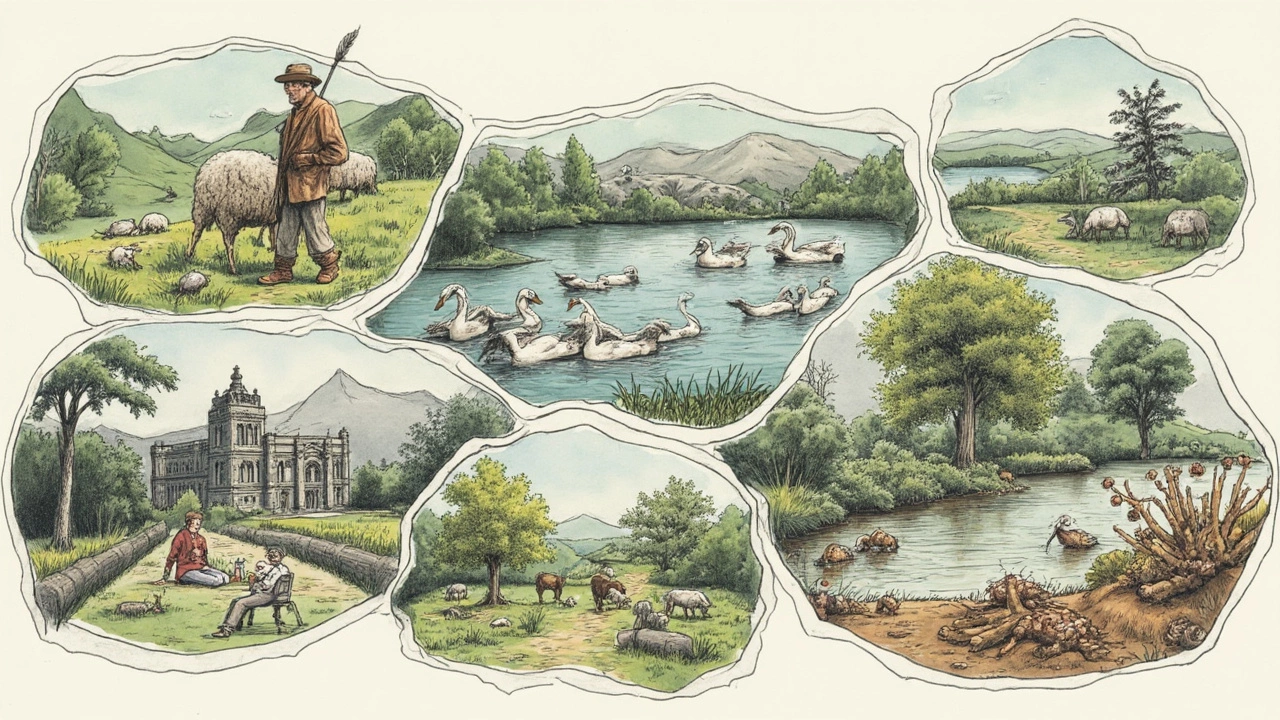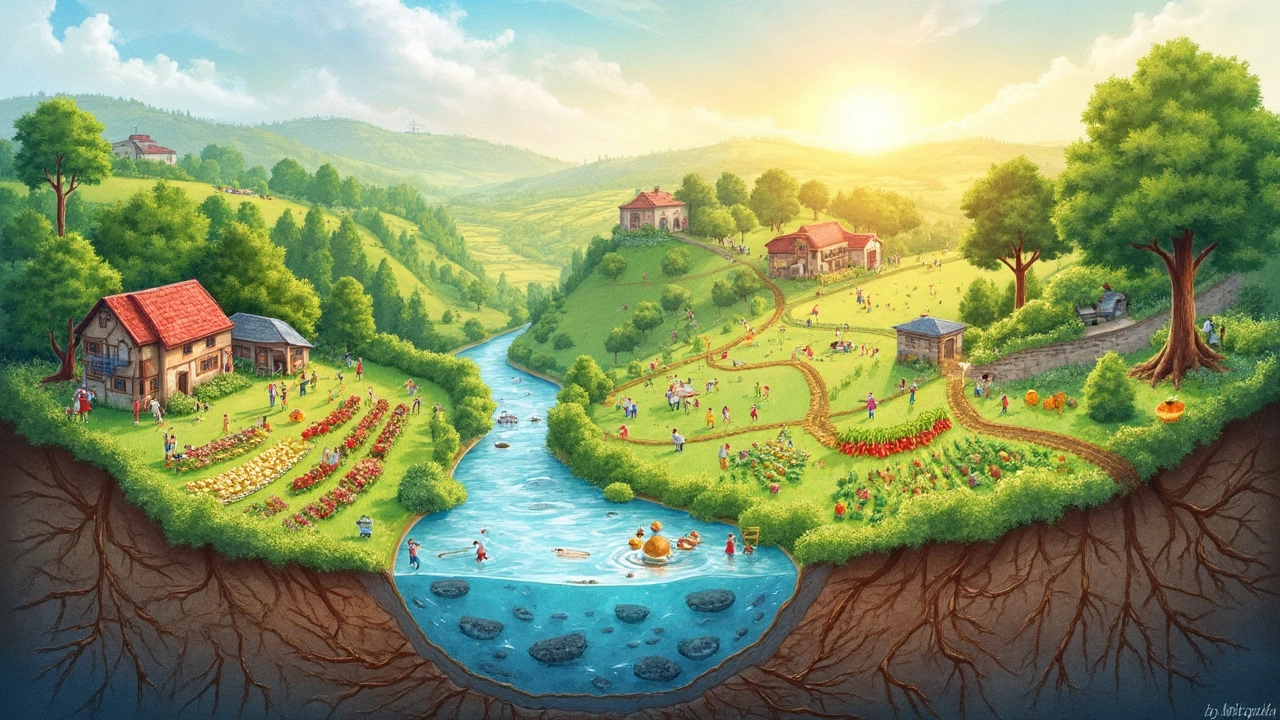Ever thought about how nature serves us every single day? From the food on our plates to the air we breathe, environmental services work tirelessly behind the scenes. These services are neatly packed into four categories, making it easier to understand the vital roles they play.
Let's break it down. First, there are the provisioning services. These are the obvious goodies nature hands us, like food, water, and raw materials. Pretty straightforward, right?
- Provisioning Services
- Regulating Services
- Cultural Services
- Supporting Services
- Real-life Examples
- Tips for Conservation
Provisioning Services
Let's start with the goodies we directly get from nature. Provisioning services are about everything tangible we harvest and gather from the environment. Think of them as nature's warehouse, stocked with essentials like food, water, and raw materials. You wake up in the morning and pour yourself a glass of water or enjoy a bowl of fruit; that’s provisioning services at work.
Consider this: nearly all the food we consume originates from ecosystems, whether it's cultivated crops, livestock products, or wild-caught fish. For instance, the lush rainforests and sprawling farmlands provide over 7000 species of plants humans consume as food globally. That's a staggering figure!
Water: The Lifeline
Clean and fresh water is another crucial environmental service. Forested catchment areas around the world filter rainfall, which ends up in our rivers and reservoirs. It's not just about quenching thirst; industries and agriculture rely heavily on water. Every sip of coffee or tea involves water use throughout its production journey.
Raw Materials and More
Ecosystems also offer up raw materials like timber, which plays a significant role in construction and manufacturing. Fibers from plants are used for everything from clothing to paper products. And let's not forget non-renewable stuff like minerals and fossil fuels that, while controversial due to their impact, remain a big part of current provisioning. Fun fact: About 90% of the world's energy needs are currently met via fossil fuels originating from ancient biological materials.
Recognizing provisioning services helps us realize how heavily we rely on these ecosystem services in our daily lives. As urban areas grow, maintaining these natural provisions is critical. It’s a balance between using resources and keeping them sustainable for future generations.
Regulating Services
Let's chat about regulating services, the uncelebrated heroes of our environment. These services are like the planet’s own maintenance crew, keeping everything in balance so we can enjoy life as we know it. Just imagine if nature didn’t pitch in to regulate!
Think about climate regulation, an essential service that helps control the Earth's temperature. Forests, oceans, and even soil act like gigantic fans, capturing carbon dioxide and helping cool things down. Without them, well, we'd likely be breaking a serious sweat.
Nature's Filters
Water and air purification are also part of the parcel. Wetlands and forests filter pollutants, giving us cleaner air and water. Here’s a fact: natural systems can remove more than 70% of nitrates, according to the Environmental Protection Agency (EPA). That’s like having a natural Brita filter, right?
Flood control is another biggie. Mangroves, wetlands, and floodplains all soak up rainwater, reducing the risk of floods. And those charming bees and butterflies? Yep, they're regulating services too. They help pollinate plants, ensuring we have crops and beautiful flowers.
"Nature is not a place to visit. It is home." – Gary Snyder
Pest and Disease Control
Then there’s pest and disease control. Many animals, like birds and bats, keep pesky insects in check, naturally balancing the ecosystem. It makes sense then, that protecting these habitats is crucial, not just for wildlife, but for us too!
In short, environmental services do much more than we often give them credit for. They keep everything ticking over smoothly, offering invaluable benefits that are easy to overlook.
Cultural Services
Nature isn't just a resource depot—it’s a huge part of our culture and identity. This whole notion of cultural services is about how ecosystems influence our lives in non-material ways. Think about the way a walk in the park calms your mind or how certain landscapes hold spiritual significance for different communities. These experiences shape who we are.
Recreation and Tourism
We all love a good adventure in the great outdoors, don't we? Whether it's hiking, camping, or a simple day at the beach, ecosystems provide endless recreational opportunities. National parks and nature reserves attract millions of visitors yearly, boosting local economies and creating employment.Spiritual and Aesthetic Appreciation
For many cultures, nature is sacred. Landscapes carry deep spiritual meaning, influencing religious practices and rituals. The aesthetics of nature, from majestic mountains to serene lakes, inspire art, literature, and photography worldwide.There's even a fun fact for stats lovers: tourism related to ecosystems accounts for a significant chunk of global travel. In 2022, eco-tourism generated billions, highlighting its importance in both cultural and economic terms.
Understanding these environmental services encourages us to protect our environments, ensuring these benefits are available for future generations. So next time you're soaking in a sunset, remember there's a whole lot more to that beauty than meets the eye!

Supporting Services
When it comes to environmental services, supporting services are the unsung heroes. They might not be as flashy as providing food or stunning views, but without them, none of the other services could exist. Supporting services are the backbone of ecosystems, making sure everything else functions smoothly.
What Do Supporting Services Include?
Supporting services kick in by maintaining the fundamental natural processes that keep our planet ticking. These include things like soil formation, nutrient cycling, and the production of oxygen through photosynthesis. Essentially, they're the processes that help other services flourish.
Soil Formation
Creating soil is no small feat. It takes up to 1,000 years to form just a centimeter of topsoil. This rich layer is essential for growing plants, which in turn feed countless creatures, including us. Without healthy soil, the food chain gets wobbly.
Nutrient Cycling
Nutrient cycling is another biggie. It's like nature's recycling program, making sure nutrients like nitrogen and phosphorus keep moving around the ecosystem. This process supports plant growth, which is crucial for ecosystem services like food production and air purification.
Photosynthesis
Everyone knows photosynthesis, the cool process plants use to turn sunlight into energy. It also involves snagging carbon dioxide and pumping out oxygen. This not only fuels plant growth but also maintains the balance of gases in our atmosphere, a key part of regulating services.
The Knock-On Effect
Supporting services are why ecosystem services are so intertwined. Take nutrient-rich soil; it supports crops that humans and animals eat, impacting everything from local communities to global food markets. Protecting soil means safeguarding food security.
Why Care?
It might be tempting to overlook supporting services since they're not as obvious as, say, clean water directly from a stream. But understanding and respecting these services is essential for conservation. After all, if the foundation crumbles, everything else follows.
In short, supporting services are the hidden scaffolding of environmental services. They ensure that nature can keep delivering its many benefits, day in and day out. Realizing this interconnectedness is the first step toward better environmental protection strategies.
Real-life Examples
When we talk about environmental services, we're really diving into how Mother Nature has our backs on so many levels. Let's look at some real-world examples that paint a clearer picture of how these categories play out in daily life.
Provisioning Services in Action
Think of fisheries. They not only provide us with food but also stimulate local economies. For instance, the salmon industry in Alaska supports thousands of jobs while delivering nutritious food to millions worldwide. This is Mother Nature working overtime just so we have something delicious for dinner!
Regulating Services at Work
Ever noticed how cities with lots of trees have a cooler climate? Trees are nature's air conditioners. They absorb carbon dioxide, give us oxygen, and even help suck up stormwater during heavy rain. Urban forests can reduce city temperatures by up to 7 °F! That's a big win against heatwaves.
The Cultural Connection
Imagine the breathtaking beauty of the Grand Canyon. Millions visit it every year for the sense of awe and the connection to something greater than themselves. Cultural services are about inspiration, recreation, and peace. These landscapes and natural wonders hold stories, offering a rich blend of history and personal exploration.
The Backbone: Supporting Services
Have you ever thought about soil and its role in agriculture? Healthy soil is crucial for growing crops. It's not just dirt; it's a living ecosystem that supports plants by recycling nutrients and filtering water. Without good soil, our food systems would be really in trouble!
Environmental protection and awareness might seem like a no-brainer, but it's all about understanding these key ecosystem services. By appreciating these examples from our everyday lives, we can start making more eco-friendly choices and support efforts towards nature benefits and environmental protection.
Tips for Conservation
Want to pitch in your part for the environment but not sure where to start? You're in the right spot. Let's dive into some easy, practical ways to help support those vital environmental services.
Reduce, Reuse, Recycle
We've all heard it before, but these three simple actions can make a huge difference. By minimizing waste, you help lessen the burden on our valuable nature benefits. Try to buy products with less packaging and recycle whenever possible.
Support Local & Sustainable
Buying local produce not only supports small businesses but also cuts down on the carbon footprint from transporting goods. Opt for products labeled as sustainable or eco-friendly, and you’re helping reinforce positive environmental protection practices.
Conserve Water
Water is part of those critical provisioning services. Little things like turning off the tap while brushing your teeth or fixing leaks can save gallons of water daily.
Create Wildlife-Friendly Spaces
Consider turning a corner of your backyard into a bird-friendly or pollinator-friendly zone. Planting native flora encourages biodiversity and supports ecosystem services.
Educate & Advocate
Stay informed about local environmental issues and share your knowledge. Encourage others to join in on conservation efforts. Advocacy can lead to broader changes and inspire community action.
Participate in Community Cleanups
Joining local cleanups can be a fun and social way to restore and protect our environments. It's a hands-on approach to caring for the environmental services that sustain us.
| Conservation Action | Potential Impact |
|---|---|
| Reducing Waste | Less landfill space, reduced pollution |
| Supporting Local | Lower carbon emissions, healthier communities |
| Water Conservation | Reserve water resources, prevent shortages |
By integrating these habits into daily life, we contribute to the preservation and enhancement of our essential environmental services. Each small step counts and can have a lasting impact.
